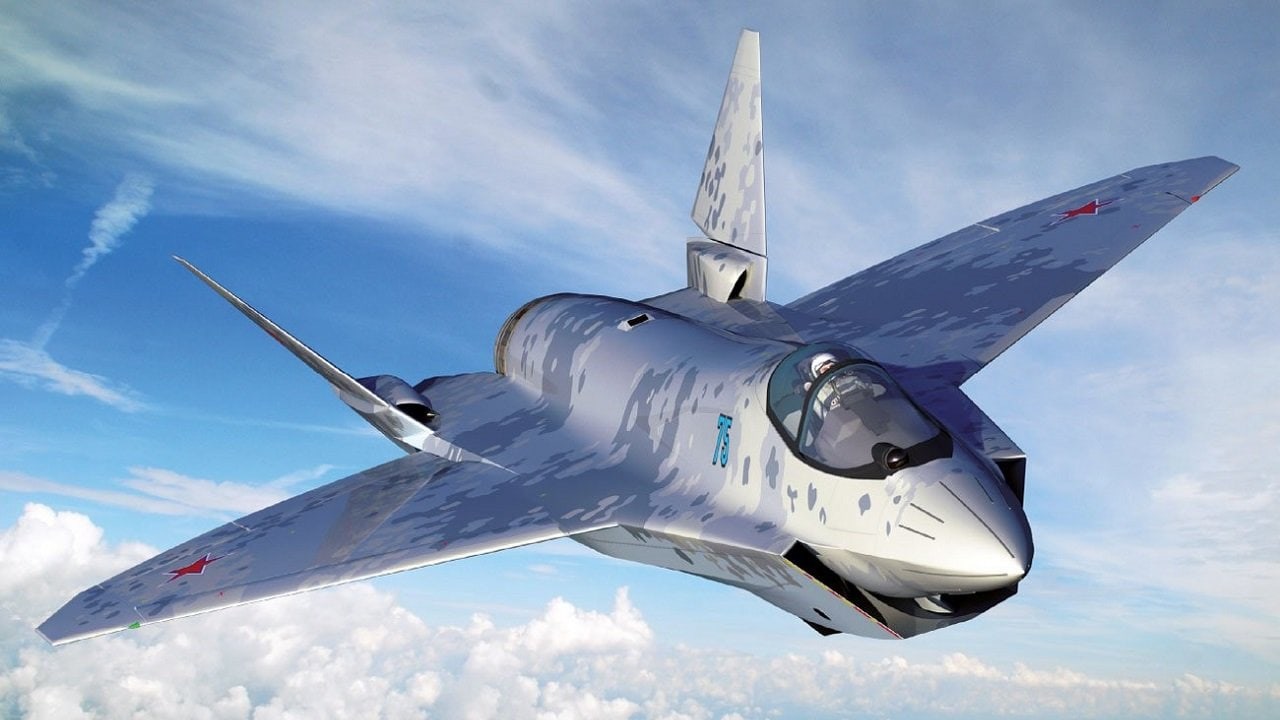Russia's New Su-75 'Checkmate' Fighter Could Feature 'Distorting Camouflage'
Russia's United Aircraft Corporation (UAC) announced that it had patented a modular modification of the Su-75 Checkmate light tactical fighter jet, which could allow the aircraft's cockpit to be changed from single-seat to double-seat or unmanned options depending on the mission.
The Russian Su-75 'Checkmate' Could Feature 'Modular' Cockpits and 'Distorting Camouflage' - The Russian Sukhoi Su-75 "Checkmate" has been touted as a low-cost alternative to the Lockheed Martin F-35, but the aircraft has largely remained in the developmental stage – so much so that it has been mocked for being little more than "vaporware."
Yet, last month, Russia's United Aircraft Corporation (UAC) announced that it had patented a modular modification of the Su-75 Checkmate light tactical fighter jet, which could allow the aircraft's cockpit to be changed from single-seat to double-seat or unmanned options depending on the mission.
The patent obtained by state media outlet Tass describes the aircraft as a "single-engine tactical jet with a small radar signature." The design and the description correspond to the previously published official images, Tass reported.
"The modification is possible due to the change of the head of the fuselage, which is most loaded with onboard equipment complexes. The fuselage comprises the basic transportation platform and at least two replaceable heads of the fuselage. The replaceable modules of the fuselage head have various functions, equipment and exterior appearance, which do not affect the aerodynamic and radar parameters of the aircraft: single (or double-seat) cockpit of a manned aircraft, the cockpit of an unmanned aircraft and others," the patent reportedly stated.
It further stated that the universal platform could "radically change functions of the whole aviation complex while keeping the transportation capabilities of the basic platform unchanged.
In this case, the replaceable cockpits would be fixed to the basic part of the fuselage, which has the connectors and nipples of electric, hydro, and other systems compatible with the connectors and nipples of the replaceable part.
"At present, military aircraft fulfill numerous missions. A broad fleet of various aircraft is necessary and demands major material and labor costs. The fulfillment of all missions by one aircraft decreases its engagement effectiveness. To reduce costs, it is necessary to modify one aircraft for various missions according to the technical base of operating organizations," the patent added.
Typically, the cockpit of an aircraft carries most of the critical equipment, but UAC's patent suggested that it a plug-and-play modular system could be employed. For example, for reconnaissance missions, it could be possible to install an unmanned cockpit and prolong the flight endurance due to a lighter weight.
"The replacement of basic modules depending on the mission and engagement conditions helps increase the aircraft engagement efficiency to the maximum and expand the range of missions fulfilled by the operator at a given time," the designer told Tass.

How quickly these modules could be changed out hasn't been addressed, nor has the cost been announced.
Su-75 Checkmate Distorting Camouflage
It was also reported this month that UAC has patented "distorting camouflage paint" for the Checkmate. The paint will reportedly complicate the visual recognition of the aircraft, as well as its search and tracking.
"This painting scheme is intended to distort the silhouette of the aircraft with its visual substitution for the silhouette of an aircraft of a different type and smaller size to make visual identification difficult and at the same time camouflage this silhouette against the background of the underlying earth's surface and clouds," the Russian Top War reported.

Su-75: What We Know
As previously reported, the Su-75, a derivative of the Su-57, incorporates the latest systems, including its open architecture configuration to meet the customer’s requirements and unique artificial intelligence technologies.
Rostec has also claimed the single-engine stealth fighter will be outfitted with an inboard compartment for airborne air-to-air and air-to-surface armaments, while it could carry a payload of over seven tonnes and will be capable of striking up to six targets at a time.
Its design is typical of a fifth-generation fighter, with diverterless supersonic inlets, internal weapons bays, and radar-absorbent coating all designed to reduce radar cross-section (RCS) and make the Checkmate a stealthy fighter. Inside, the cockpit appears to be laid out almost identically to the Su-57. Its avionics include active electronically scanned array radar, a must in modern fighters as well as open architecture code which greatly eases the update process.

However, because there has been much hype about the aircraft, with little actual substance, the Su-75 "Checkmate" has been dubbed vaporware – a reference software and hardware that never materializes after being introduced often with much fanfare. UAC has applied for patents, but yet, hasn't actually demonstrated the aircraft. Perhaps that says all we need to know about the Checkmate.
Author Experience and Expertise: Peter Suciu
Peter Suciu is a Michigan-based writer. He has contributed to more than four dozen magazines, newspapers, and websites with over 3,200 published pieces over a twenty-year career in journalism. He regularly writes about military hardware, firearms history, cybersecurity, politics, and international affairs. Peter is also a Contributing Writer for Forbes and Clearance Jobs. You can follow him on Twitter: @PeterSuciu. You can email the author: [email protected].


